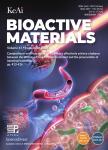Anisotropic scaffolds for peripheral nerve and spinal cord regeneration
作者机构:Mary&Dick Holland Regenerative Medicine ProgramUniversity of Nebraska Medical CenterOmahaNEUSA Division of CardiologyDepartment of Internal MedicineUniversity of Nebraska Medical CenterOmahaNEUSA Department of SurgeryUniversity of Nebraska Medical CenterOmahaNEUSA Department of Mechanical EngineeringUniversity of Nebraska-LincolnLincolnNEUSA
出 版 物:《Bioactive Materials》 (生物活性材料(英文))
年 卷 期:2021年第6卷第11期
页 面:4141-4160页
核心收录:
学科分类:0831[工学-生物医学工程(可授工学、理学、医学学位)] 08[工学] 0836[工学-生物工程]
基 金:the National Institute of General Medical Sciences,1U54GM115458 the UNMC Center for Heart and Vascular Research
主 题:Tissue engineering Topography Alignment Surface pattern Hydrogel
摘 要:The treatment of long-gap(10 mm)peripheral nerve injury(PNI)and spinal cord injury(SCI)remains a continuous challenge due to limited native tissue regeneration *** current clinical strategy of using autografts for PNI suffers from a source shortage,while the pharmacological treatment for SCI presents dissatisfactory *** engineering,as an alternative,is a promising approach for regenerating peripheral nerves and spinal *** providing a beneficial environment,a scaffold is the primary element in tissue *** particular,scaffolds with anisotropic structures resembling the native extracellular matrix(ECM)can effectively guide neural outgrowth and *** this review,the anatomy of peripheral nerves and spinal cords,as well as current clinical treatments for PNI and SCI,is first *** overview of the critical components in peripheral nerve and spinal cord tissue engineering and the current status of regeneration approaches are also *** advances in the fabrication of anisotropic surface patterns,aligned fibrous substrates,and 3D hydrogel scaffolds,as well as their in vitro and in vivo effects are ***,we summarize potential mechanisms underlying the anisotropic architectures in orienting axonal and glial cell growth,along with their challenges and prospects.



